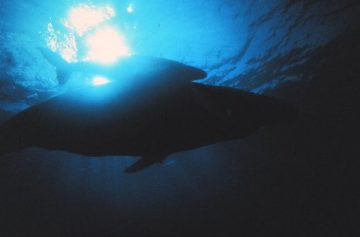Every year, between December and April, humpback whales can be seen in the waters around Punta de Mita. They leave their summer feeding grounds, migrating from Northern California (and even as far as Alaska), swimming hundreds of miles south to mate and give birth in the warm, calm waters of Banderas Bay. Their stays generally last for 4 months but are sometimes longer.

During the mating season, male humpbacks are the only cetaceans that compete and fight for the females’ attention. Some of their behaviors include breaching, slapping their tails and fins, and singing.

Breaching
Breaching is a surfacing behaviour, where the whale propels itself almost completely out of the water in spectacular leaps. There are a number of theories for this behavior – to communicate, to attract other whales, or to warn off other males – but, like much of whale behavior, little is known for sure.

Tail slapping
Tail slapping occurs when a whale (or dolphin) lifts its tail flukes out of the water and then smashes them down onto the water’s surface, resulting in a loud slap. These behaviors may be used to communicate, scare fish or may be a display of aggression.
Singing
Male humpback whales are known for their mysterious songs. Whale song – a sequence of moans, howls, cries, grunts, squeaks, bleats and other complex sounds – can continue for hours on end, resembling something like a symphony.
Different groups of humpbacks have different songs (like different languages). Whale song only occurs while in the mating grounds, and although it is most likely used for communicating and attracting mates – scientists are still trying to figure out what the sounds mean.
Some other interesting whale behaviors you might see include:

Photo: Courtesy of NOAA
Spy-hopping
Spy-hopping occurs when a whale lifts its head, and part of its chest, vertically out of the water, so that their eyes are just peeking past the water line.
Blowing
Unlike humans, who breathe involuntarily, whales must consciously think about surfacing to breathe. For this reason, whales never actually go to sleep, and instead keep one-half of their brain active to focus on breathing. As whales surface, they blow air, water vapor and mucus in order to take a breath.
Ready to go Whale Watching in Punta Mita?
Want to spend more time with these gentle giants? Consider taking a 3-hour tour with our marine biologist. Learn about the breeding habits of whales and their markings, and listen to whale song live on a hydrophone system.
Another option is to join one of our captains for on a tour of the Marietta Islands, where you will see not only whales but also the legendary Blue-footed Booby bird. This leisure tour also allows time for snorkeling or kayaking.
If you prefer a more intimate whale watching experience, we offer catamarans and private boats.
All of the tours provide equipment as well as snacks (guacamole, salsa, ceviche, beer, soft drinks and water).
Contact our concierge at info@tripwix.com







